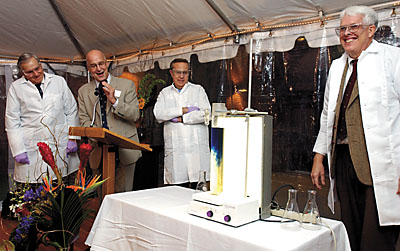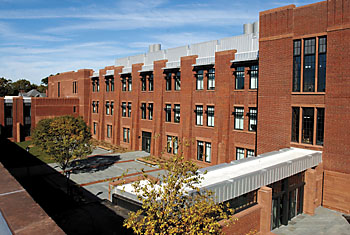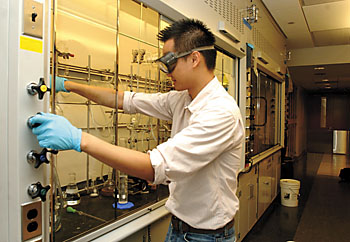 | Joel Smilow '54E (far left), Provost Andrew Hamilton, President Richard C. Levin and Professor Michael McBride demonstrated the power of collaboration at the dedication of the Class of 1954 Chemistry Research Building. |
The Class of 1954 Chemistry Research Building, conceived to maintain and enhance Yale's excellence in the sciences, was dedicated on Oct. 24 and hailed as the next significant step toward fulfilling the University's $500 million commitment to the sciences.
"This is the first, new, heavy-duty, hard-core science building at Yale," President Richard C. Levin said of the $50 million brick and brownstone structure located at 285 Prospect St. "The opportunity to raise Yale science to national pre-eminence has never been better."
The 105,000-square-foot, three-story building is the result of a generous gift by the Class of 1954, the largest class gift in the University's history.
Representing the Class of 1954, Joel Smilow '54E said at the ceremony outside the building that Levin was "persuasive, impactful and passionate" in urging the alumni to use a large portion of the fund's proceeds for the new building. Smilow said that in the interests of philanthropy, the class was intent on helping to bring about something that would truly make a difference to the University and that would leave the class' imprint on Yale for generations to come.
"No other buildings on campus have been named for a class," he said, adding that he hoped someday future grandchildren will be able to point to the buildings and say, "You know, my granddaddy was in that class."
Gary Brudvig, professor and chair of the Department of Chemistry and professor in the Department of Molecular Biophysics and Biochemistry, said the new building will be critical in recruiting the best faculty and the best students. Thanking the Class of 1954, he said, "This is a statement by the University in support of chemistry."
The building is designed for hood-intensive research involving the synthesis of new molecules. Each floor is dedicated to one of three areas -- synthetic organic chemistry, inorganic chemistry and chemical biology. Brudvig said there already are several exciting projects underway, among them developing new materials for solar energy utilization and new catalysts to facilitate hydrogen storage to increase its practicality as a fuel source and investigating the molecular basis for energy transduction in plant photosynthesis.
Donald Crothers '58, Sterling Professor Emeritus and former chair of chemistry and professor emeritus of molecular biophysics and biochemistry, said the building was the fulfillment of a longstanding dream of the department, a dream made possible by the Class of 1954's financial acumen and fierce loyalty to Yale.
"This gift has allowed the project to go forward on a scale that would not have been possible," he said. "The impact of this building is just beginning."
Provost Andrew Hamilton, the Benjamin Silliman Professor of Chemistry and professor of molecular biophysics and biochemistry, said the building was made possible by a critical collaboration between the administration, the faculty and the Class of 1954. To demonstrate the strength of the collaboration, Hamilton had a representative from each group help to create a chemical reaction in which three clear liquids were mixed together, resulting in an oscillating reaction in which the solution cycled from yellow to red and then to Yale blue.
"It only works when all three components of the reaction are present," Hamilton said. "Cooperation is vital for continued Yale success, as this reaction continues again and again and again."
Project manager Richard Vollaro said the building has 147 fume hoods and 37 laboratory modules, all located on the north side of the building, as well as faculty offices, computation rooms and other office rooms. "This is a very highly intensive mechanical and electrical system," he said. "It is among the most complex buildings at the University."
The interior, which was designed by Cannon Design, has break-out areas to build a sense of community and to foster collaboration and an exchange of ideas. One of the primary objectives in designing the building was that it be flexible, modular and adaptable to meet the changing needs of the researchers. The eight-foot fume hoods are two to three feet larger than the industry standard, and there is storage for corrosives, flammables and vacuum pumps.
The exterior, designed by Bohlin Cywinski Jackson of Pittsburgh, features a common courtyard with Kline Chemistry Laboratory. It also features an unusual gate designed by Yale architecture professor Kent Bloomer with input from faculty members from the Department of Chemistry.
Bloomer apparently attended the faculty's informal brown-bag lunch meetings to brainstorm about what would be appropriate on the gate, which is designed to bridge the span between the new chemistry building and the existing Kline Chemistry Laboratory. Bloomer majored in physics at the Massachusetts Institute of Technology.
"He asked what would represent us best," said Ann Valentine, an assistant professor in the Department of Chemistry. "We decided we wanted to have something that represented organic chemistry, inorganic chemistry, physical chemistry and biochemistry, at the very least."
The group also decided to limit their depiction of specific Yale chemistry to the Nobel Prize-winning finding by Lars Onsager, who introduced a new way of thinking about phases, such as when ice melts into water. His discovery is illustrated in the middle part of the gate by arrows pointing up and pointing down, a representation known as an Ising lattice.
The various fields of chemistry are illustrated on both sides at the top of the gate to represent carbon atoms for organic chemistry and metals for inorganic chemistry.
"Then we decided to have some fun with the biochemistry part," Valentine said. "It's kind of an insider, nerd joke." Using the letter code abbreviations for the 20 naturally occurring amino acids, the decorative element on either side spells out "Yale" and "Chem."
-- By Jacqueline Weaver
T H I S
Class of 1954 Chemistry Building
officially opened

The Class of 1954 Chemistry Research Building.
The Class of 1954 Environmental Science Center, dedicated in 2001, was also made possible by the class gift and has already made substantial contributions to interdisciplinary work on Science Hill. In addition, the class' gift has paid for extensive renovations to the Yale Bowl and established a matching fund to support other University priorities.

In addition to its state-of-the-art work spaces, one of which is shown here, the Class of 1954 Chemistry Research Building is designed with many eco-friendly features.
The building was constructed to meet Leadership in Energy and Environmental Design (LEED) certification standards. The LEED standards are mandated by the U.S. Green Building Council, a coalition of leaders from across the construction industry dedicated to making buildings both eco-friendly and profitable. These features include heat recovery, variable fume hoods and occupancy sensors. The building treats storm water for sediment, phosphorus, oils and other pollutants and uses flush water from the dionization system for toilet water instead of city water. Condensate from the air conditioning in the building is collected and used for landscape irrigation. The building's indoor air quality was also improved by choosing better building materials that produce fewer emissions. It was purged with air for two weeks before anyone moved in.
 W E E K ' S
W E E K ' S S T O R I E S
S T O R I E S![]()
 Yale expands its policy on sick leave
Yale expands its policy on sick leave![]()
![]()
 Researcher finds lower payments for treatment affect . . .
Researcher finds lower payments for treatment affect . . .![]()
![]()
 Faculty to study cell interactions in NIH project
Faculty to study cell interactions in NIH project![]()
![]()
 In trail guide, employee showcases her hometown's natural splendors
In trail guide, employee showcases her hometown's natural splendors![]()
![]()
 NIH grant supports network for research on preterm birth
NIH grant supports network for research on preterm birth![]()
![]()
 Library is a 'treasure-house of history,' says author
Library is a 'treasure-house of history,' says author![]()
![]()
 ENDOWED PROFESSORSHIPS
ENDOWED PROFESSORSHIPS
 Anthropologist Burger is appointed as MacCurdy Professor
Anthropologist Burger is appointed as MacCurdy Professor![]()
 Anthropologist Hill is designated as Stephenson Professor
Anthropologist Hill is designated as Stephenson Professor![]()
 Political scientist Wallerstein is named as Saden Professor
Political scientist Wallerstein is named as Saden Professor![]()
![]()
 University pays tribute to Robert Penn Warren . . .
University pays tribute to Robert Penn Warren . . .![]()
![]()
 Entertainer and activist to give Chubb Lecture
Entertainer and activist to give Chubb Lecture![]()
![]()
 Events mark century of Native American presence at Yale
Events mark century of Native American presence at Yale![]()
![]()
 Yale Law Journal launches an online companion publication
Yale Law Journal launches an online companion publication![]()
![]()
 Next Dean's Workshop focuses on the electron microscope
Next Dean's Workshop focuses on the electron microscope![]()
![]()
 Campus events celebrate German dramatist Friedrich Schiller
Campus events celebrate German dramatist Friedrich Schiller![]()
![]()
 Memorial service for Abraham S. Goldstein
Memorial service for Abraham S. Goldstein![]()
![]()
 A call for action
A call for action![]()
![]()
 Campus Notes
Campus Notes![]()
Bulletin Home |
| Visiting on Campus
Visiting on Campus |
| Calendar of Events
Calendar of Events |
| In the News
In the News![]()
Bulletin Board |
| Classified Ads
Classified Ads |
| Search Archives
Search Archives |
| Deadlines
Deadlines![]()
Bulletin Staff |
| Public Affairs
Public Affairs |
| News Releases
News Releases |
| E-Mail Us
E-Mail Us |
| Yale Home
Yale Home